No London Show again? Read about the last Wakefield one instead!
Due to circumstances beyond the control of the organisers, last year’s Wakefield Show morphed into the Wradfold show – Wakefield, but in Bradford – and this year, the show carried on in the same location, for much the same reason. It took place on 22nd April at the Cedar Court Hotel in – well, yes – Bradford.
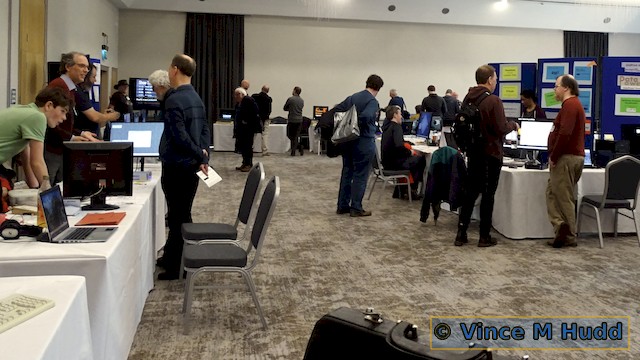
Visitor numbers seemed light again, likely to be the same reason as the 2022 show; with the worst of the pandemic only a few short years behind us and the general demographic of RISC OS users weighted towards older people, lower numbers are likely to be continue for a while yet. However, according to the organisers themselves (in the May edition of their newsletter, the WROCC) it was more crowded this time. Both of these could be true, though – it may have been more crowded than last year and for the reason I’ve given, numbers could still be lower than a few years ago.
It should also be noted that the way things feel in terms of visitor numbers can be affected by the amount of space – the room used in Bradford is much larger than the (combined) space in Wakefield, which would make the former feel less crowded even if the same numbers came through the doors.
Regardless of any of that, amongst those that did attend there was generally positive atmosphere – not uncommon at these events, in all honesty – and the show felt quite upbeat, with some exciting things announced and shown off.
That said, I do have some criticism of this year’s event – both from my personal perspective as an exhibitor, and a more general one. This is largely to do with the way the floor was laid out, and will also have a bearing on the way this report proceeds. I try to adopt a ‘route’ around the show for these write ups that follows a straightforward, logical path, starting with the first exhibitor a visitor would encounter – the organising group’s stand, where an entrance fee is paid – and ending with whichever exhibitor is the last one on the other side of the way in.
I can do that this time – the floor layout still allows such a route (it would be hard to avoid it, really) – and I therefore will do so, but to illustrate the issue, here’s the floor layout, taken from the Wakefield 2023 website:

The way in is at the bottom left, with stand 1 being the Wakefield RISC OS Computer Club (WROCC) – the organisers. Adopting that as the first to write about and making the route follow the stand numbers sequentially is perfectly logical, allowing me to end on stand 21.
That would be ideal if stand 21 was one of the community’s bigger players, such as the owners of the operating system, or the company whose role it is to look after and maintain it, but the table sizes as shown on that plan should make it obvious to all but the casual viewer that those exhibitors were elsewhere in the hall.
So who or what was on stand 21? Well, I’m going to leave this at a cliffhanger – you’ll have to read on to find out, and I’ll add more thoughts about this, including why I wasn’t over the moon as an exhibitor, at the end. Meanwhile, on with the report…
The Wakefield RISC OS Computer Club (WROCC)
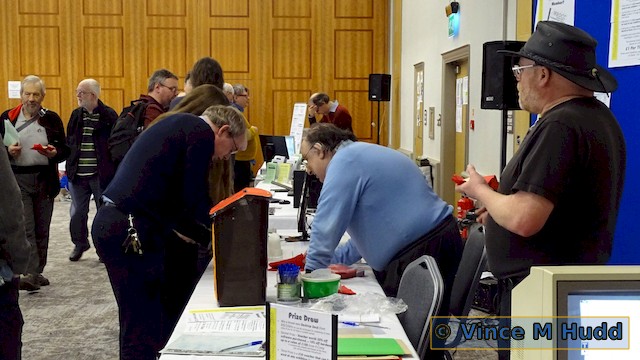
So, starting at stand number one, this was the Wakefield RISC OS Computer Club (WROCC) – the event’s hosts, and one of the ‘big name’ user groups for the platform.
WROCC hold regular online meetings that anyone can join, on the first Wednesday of the month with occasional exceptions, covering topics that might range from the guest speaker’s latest piece of software for RISC OS, a recent project they’ve worked on (for example, Mark Moxon recently spoke about the updates he’s made to the 8-bit version of Elite), or other relevant or interesting subject.
Membership of the group costs just £7.50 per year, and as well as the sense of pride that comes from enabling the WROCC to continue doing what it does, members also get a monthly newsletter delivered as a PDF to their email inboxes, and access to a private discussion list.
There were raffle tickets available to buy – with a limit on the number each punter could buy, which made me wonder if it would have been worth donning a disguise in order to double up. The winning tickets were drawn in the afternoon, and prizes dished out as follows:
- First prize of a Desktop Dock from RISCOSbits went to Andrew Pinder.
- Second prize of a 50% discount from software/10% from hardware from R-Comp, up to a maximum of £100, went to Anil Patel.
- Third prize of a £50 voucher that could be used with any exhibitor (who was selling anything – presumably enough to reach that amount) went to Mark Stephens. (That Icon Bar chap).
- But it doesn’t end there – three prizes weren’t enough. Fourth prize – a copy of TextEase Studio and a printed manual from Elesar went to Richard Wadsworth.
- And that’s still not it, because there was a fifth prize as well, another £50 voucher for use with any show exhibitors. That went to Rob Speed.
- Enough? No! There was a sixth prize as well; a first edition copy of Acorn – A World in Pixels, and that went to Andrew Pinder (who also won the first prize).
The club has now been running for some forty (count ’em) years, and to celebrate, they arranged for a little extra something at this year’s show:
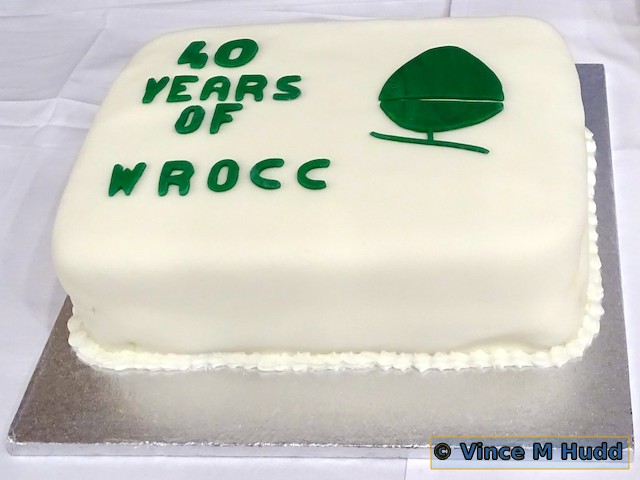
When cut, the cake was distributed amongst anyone who wanted a slice – exhibitors and visitors alike. And very enjoyable it was, too.

RISCOSbits
With the hosts cast aside, the next exhibitor was RISCOSbits, where Andy Marks had an array of interesting items.

The newest range in the RISCOSbits line up was FAST. Standing for Fast Access (to) Storage Technology, the essence of FAST is a combination of a slightly different version of RISC OS coupled with a small hardware device that allows the PCIe port on the Pi Compute Module IO board to be used, in turn making four full speed SATA ports available to RISC OS.
This is what allows RISC OS FAST to live up to its name, because the exceedingly quick access to the filing system provided by this speeds up any task that involves loading and saving data, and can particularly shine through on those that are particularly disc intensive.
RISC OS FAST comes in a number of flavours, from a very basic ‘kit’ right up to a range of fully fledged systems, with an example on display at the show:

FAST is more than just about accessing full speed SATA drives, though; other features of planned, such as the ability to play with larger drives – which doesn’t simply mean insert a big drive, but format it in such a way that most of its capacity goes to waste. To truly benefit, RISC OS needs to be able to utilise that capacity. To illustrate this, look again at the picture of the computer above. Notice that there’s just one thing open on the desktop? Let’s take a closer look at that:
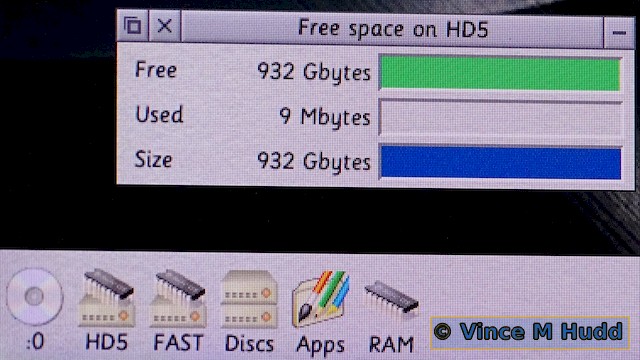
Wow. That’s a great deal of gigs for a RISC OS box! What else is there that needs to be said?
Fantastic as FAST may be, that wasn’t the be all and end all of what RISCOSbits had available for the show-goer to look at, talk about, and buy. As well as other computers, kits, and cases from their extensive range, another recently introduced product was available as well.
In the world beyond RISC OS (I know, I know, but bear with me) there are more choices for laptops than you can shake a USB stick at, yet its becoming increasingly common that you might struggle to plug in that same USB stick because of the limited number of ports on the computer – especially if you’re using it on your desk, with a decent keyboard and mouse, etc.
The solution is to use a device that might variously be called a desktop dock, a laptop dock, or something else that includes the word dock. Loosely descended from manufacturer/model specific ‘docking stations’ of the past, these are essentially more generic devices that connect to your computer to provide a number of additional connections, and not just more USB ports; ethernet, for example, and one or more display output options are all very common.
And it is one such device that RISCOSbits had available.

Compatible with the Pi-Top v2, Pinebook, and Pinebook Pro (and also with systems that tend to be used on a desk in the first place) the device provides a DVI port to allow the use of an external display, an ethernet port, four USB 2.0 ports and one USB type B, and so on, and makes the computers feel more like a desktop machine when they happen to be used on a desk.
Sine Nomine
If you could find your way from RISCOSbits to the next exhibitor – at the set of tables immediately after – that exhibitor, Sine Nomine, could provide you with something to help you do just that.

Sine Nomine’s ‘headline act’ in recent years has been their mapping application RiscOSM, which makes use of data sourced and converted from Open Street Map, and they’ve developed a few satellite applications that relate to RiscOSM in one way or another, such as Recce which will take a location from the map software and seek out additional data from various online sources that relate to that location, such as pictures, weather information, and so on.
At this year’s Wakefield event another related application was introduced, a route planning tool that will work out the best way to get from A to B, and cunningly called AtoB.

The program allows you to choose not just the start and end points, but also way-points – places you want to visit or pass along the way – as well as the method of travel. The result is presented as a set of step by step directions, which can be printed out and taken with you, or it can also be sent to RiscOSM so that the route can be shown on a map, and there are even a number of export options, including as a GPX file, which could be useful with a handheld satellite navigation unit.
Switching to a different type of software, another application that has been updated is ImpEmail, a program for performing mail-merges and sending the results out by email. The program can also merge documents for attaching to emails, but one type of file that is probably the most useful for this, but also problematic for producing are PDFs, since they are essentially a platform agnostic (i.e. portable – the ‘P’) document format (that’s the ‘DF’).
The new version of ImpEmail can now do this, thanks to changes made to another application by its developer, allowing the production of PDFs to be done with some inter-app communication (aka an application programmer interface, or API). The upshot is that ImpEmail can specify where the resulting PDF should be placed, so that once it is produced it can be picked up and used, and then the next one produced, and so on until the mail-merge is complete.
Matthew Phillips of Sine Nomine gave one of the day’s talks, in which his main topics were RiscOSM and the related applications, and ImpEmail and this new feature in particular:
Don’t worry about the lights going out and plunging the entire video into darkness shortly before 15 minutes into the video – I think that was a technical glitch with the recording(s).
As the video reveals, the third party application used by ImpEmail for generating PDF files as part of its mail-merges is PrintPDF by Steve Fryatt. Speaking of Steve, can you guess who was the next exhibitor along?
Steve Fryatt
Too easy, right? Yup – the next exhibitor was indeed Steve Fryatt, and he’s inviting you to play a variation of a very old, and very simple game…
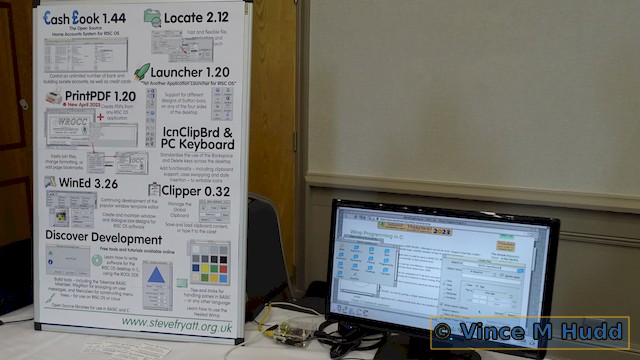
As usual, Steve was demonstrating the variety of software he has developed for RISC OS, and as the write up above about Sine Nomine reveals, there is a new version of PrintPDF available – Version 1.20, which offers an API that can be used by other applications so that they can use it to produce PDF files in a way that means they can then do something themselves with the resulting files.
The way PrintPDF works is that it acts as a front-end to something called GhostScript, and presents the user with a more friendly way to get from a native document in whatever application they’re using to a final document, in a more widely used format (i.e. PDF), by way of the printing system. Hence the name, PrintPDF – you’re printing your document to a PDF file, rather than to an actual printer.
The software offers a number of options, such as adding bookmarks to the PDF document, combining documents together, and so on – and now the API to allow other applications control of PDF generation.
Stader Software Development
Next to Steve was a first time exhibitor at Wakefield. Visiting the UK from beyond UK shores, Thomas Milius was there to show off the products he has available from his company Stader Software Development.

Thomas has released some useful applications through his company, such as DeskWatcher and Retriever, and even more items under his own name, including a DICOM image viewer, a HTTP server, and much more. He was happy to talk to visitors about any of this, demonstrating how it works, and explaining to people how they could get hold of it, but he was unable to sell anything on the day because he was visiting under a limited visa.
Amongst his own projects displayed at the show was a computer built into a briefcase, making it portable and usable on the go. Based around a BeagleBoard and using a keyboard with built in tracker ball to use instead of a mouse – and of course this was running RISC OS.

GAG News is the newsletter/magazine of the German Archimedes Group, and although he isn’t the publisher – that’d be Herbert zur Nedden – Thomas had brought a few copies with him so that RISC OS users in the UK could see what it was like.

Charity stand
The Wakefield Show – and user group – has a long tradition of supporting the Wakefield Hospice, with the money raised by the charity stand and prize draw always heading in that direction, and this year was no different.

The money raised at this year’s show was £955.75, and WROCC’s Chris Hughes delivered a cheque to the Hospice in June for a rounded up £1,000. Over a period of twenty eight years, the running total now sits at a little over £28,000, so this year’s sum was pretty much the average (mean) amount which itself is a good result.
If you are a WROCC member and therefore receive their newsletter – or if you picked up a copy of the back issues disc from their table – check out the July 2023 issue (41:4) and you’ll find a letter from the Wakefield Hospice offering their thanks, and the local newspaper, the Wakefield Express, included a had an article in June about the club’s long support.
Archive Magazine
A couple of stands back we saw the long-running printed German magazine GAG News shown off by Thomas Milius, visiting from those distant shores, but now we come to a long-running British magazine – Archive.
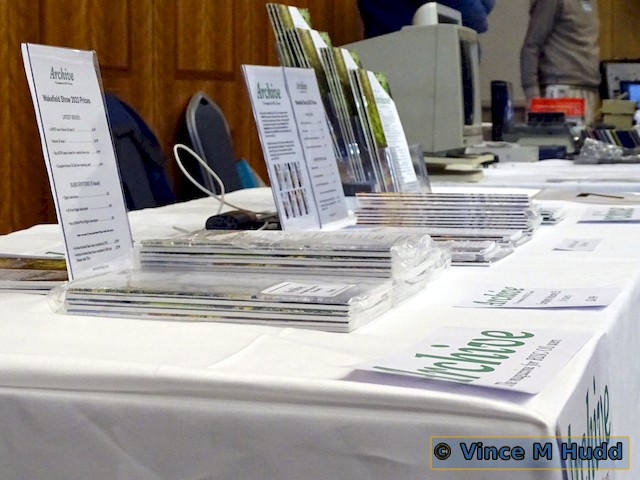
Unable to make it to the show in person, like last year editor Gavin Smith had arranged for Colin Piggot – who writes the retro column for the magazine – to appear on his behalf, to talk to existing subscribers, punt the magazine to potential subscribers, and provide a selection of back issues.
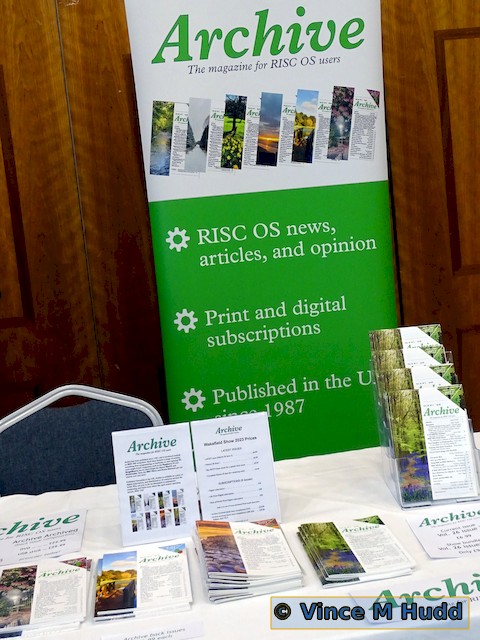
As well as writing for Archive, Colin has a particular niche of his own, a very underrated computer released towards the end of the 1980s called the SAM Coupé. This was a machine that was designed and marketed with a high degree of compatibility with a more well known machine from the other end of the decade; the Sinclair Spectrum – and very much a machine that was on my wish list at the time, but never added to my then collection. There’s always the possibility of buying one now, of course, but I don’t want one that much – or indeed this much!
If I did have one, though, in much the same way that I read Archive as a RISC OS user, I’d probably be reading SAM Revival, the magazine published by Colin in support of the computer.
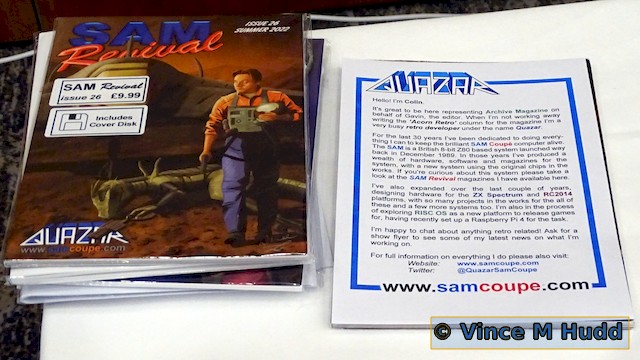
The magazine is published as part of the Quazar brand name, through which Colin offers both software and hardware for the computer, such as an interface for cartridges for the VIC-20, allowing some software written for the 6502-based Commodore computer to run under emulation on the Z80-based Coupé.

8 Elesar Ltd
As a source for RISC OS-related hardware and software, though, the next exhibitor had you covered. That was Elesar Ltd, the source of – amongst other things, the Titanium motherboard.

With a Cortex-A15 at its heart, the Titanium has been around for a few years now (eight of them, if you’re counting), but despite that, it’s a particularly interesting beast – not least because it’s a motherboard designed for RISC OS, rather than one made for other reasons and to which the operating system has subsequently been ported.
The company also does a nice line in mechanical keyboards – chunky black ones with red function keys, giving a BBC Micro vibe to your desk. These are even available with an alternative key-cap for the ‘logo’ key; instead of the common Windows ‘flag’ (which is an option), they can be had with a cog symbol; a monochrome version of the logo long-since adopted for RISC OS.

If you have all the hardware you need, though, and you’re more interested in software, Elesar can help you out there, as well – with an ever growing selection available, some that Rob is now looking after on behalf of its original developers and some developed in-house – and an example of the latter, CloudFS, was updated about a week before the show.
RISC OS Open Ltd (ROOL)
Rob has a long association with RISC OS Open Ltd (ROOL), who look after the operating system on behalf of its users, often representing the company at shows and giving talks on their behalf, so it’ll come as no surprise to anyone to discover that they had the next stand.
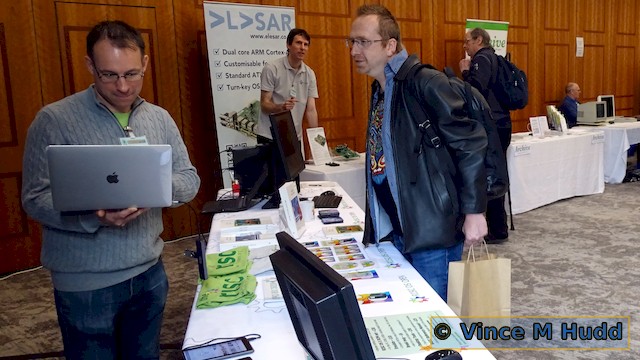
There is usually a range of goodies available to buy from ROOL, including manuals, software such as the latest development tools, and a range of merchandise – to which a new item was added this year: the puntastic ROOL Rule.

The company is currently working towards the next stable release of RISC OS – 5.30 – and part of the ROOL theatre talk, which was given by Rob, covered the state of play at the time, which he estimated as being around two thirds complete.
The talk was divided into three parts, differentiating what is expected in the near-term, the mid-term, and the long-term (aka ‘plans for the future’). The status of the RISC OS 5.30 work fell under the first of those, and as part of that he covered some of the changes that would be going into it – including the full read/write version of SparkFS from David Pilling, and a new version of Paint with a long-standing bug finally fixed, and some welcome new features:
RISC OS Developments Ltd
Crossing from the outer part of the ‘U’ to the inner, the next exhibitors were listed on the show website as Orpheus Internet followed by RISC OS Developments, but just to confuse matters, Richard Brown of both companies set up the stands the other way around – so RISC OS Developments (ROD) came first.
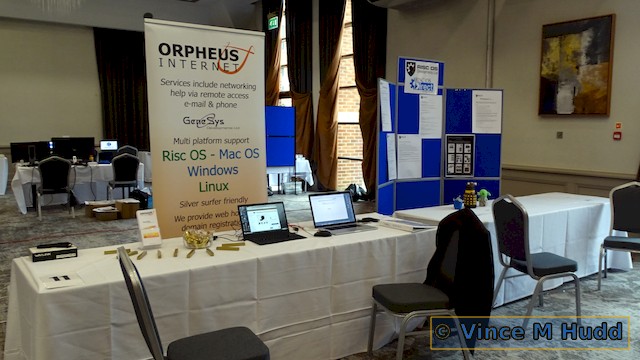
To confuse matters even more, the RISC OS Developments stand looked flashier than usual, because Andrew Conroy put in an appearance and had a very small number of his flashing toys on display; devices that can be connected to a Raspberry Pi, and for which Andrew has written driver software.

And next to Andrew’s toys, Richard’s daughter Serena had brought along her Yoda and the bursting pod from Alien. Hopefully, since the Southwest Show someone may have explained to Yoda that it’s not an alien pod, but actually a (blue) raspberry, so he needn’t look so worried – yet he still does. That might be because there’s now a Dalek there!

Extra exhibits aside, Richard was on hand to explain the company’s latest developments to the web browser, Iris, Pinboard 2, and more besides, and covered some of this in his slot in the show theatre.
While RISC OS doesn’t as yet support Wi-Fi, when that particular problem is solved and it does, anyone with a Wi-Fi equipped computer that gets taken from one place to another is going to want to be able to easily configure their machine to use the available network, and to be able to save that configuration for future (re)use. And that, in a nutshell, is the network profile manager, which he also demonstrated (such as he could, with no actual Wi-Fi or network connection) in his talk.
Orpheus Internet/Genesys Developments
The second stand that Richard was manning was the Orpheus Internet one, where people could talk to him about the services offered by the RISC OS-friendly ISP, either as a potential customer, or an existing one.

He covered some of the Orpheus news in his theatre talk, and to add to the confusion he was aiming to cause to anyone who had seen the exhibitor list and floor-plan on the show website, by switching the RISC OS Developments and Orpheus stands around so that the latter first and the former came after, he went the other way in his talk, with Orpheus first and RISC OS Developments second.
He covered two main subjects in the Orpheus part of the talk. Firstly, there have been price changes as a result of BT, his supplier, changing theirs – although that hasn’t meant price rises in all cases; some customers have had their bills reduced slightly. And secondly, with BT planning to switch off their analogue systems, there is likely to be a whole new service – voice over IP telephony – that Orpheus will be able to offer from 2025.
12 R-Comp & R-Comp Interactive
The other main face of RISC OS Developments is Andrew Rawnsley, who also runs R-Comp and could be found on the next stand.
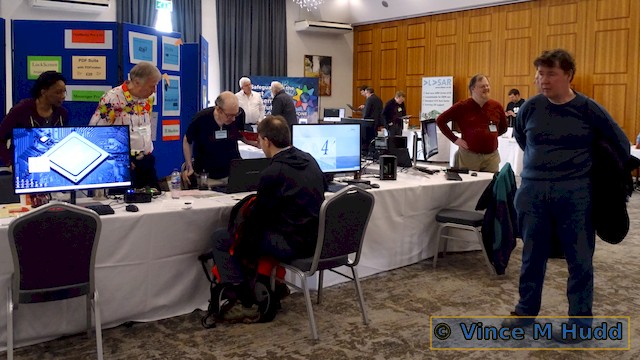
The company had brought along an extensive range of hardware and software, as always, including some new toys to impress the show visitors and hopefully tempt them into buying, such as a multi-headed monster called Hydra.

The computer features an ITX motherboard designed to use up to six Pi Compute Modules, each with its own NVMe storage and able to run its own operating system, such as RISC OS on one, Linux on another, and so on. With the magic of VNC added, that means both accessible on the same screen from within the same computer, at the same time, rather than having to run one or the other, or having to run more than one machine at the same time.

Another new machine was the RockyRAID, with a name that comes from the processor in use combined with the hard drive configuration – that’d be a Rockchip RK3399, and two hard drives in a RAID 1 configuration.

RAID stands for Redundant Array of Independent Discs, and level 1 basically means the drives are mirrored – when data is written to one, it also gets written to the other, so if either drive fails, nothing is lost; things can carry on with the other, and when a replacement drive is added, it will become a new mirror.

Now, in the picture above, you’ll note that the piece of paper next to the computer says 4tissimo! Well, that’s because of the way things were laid out on R-Comp’s tables – because that isn’t 4tissimo! This is:
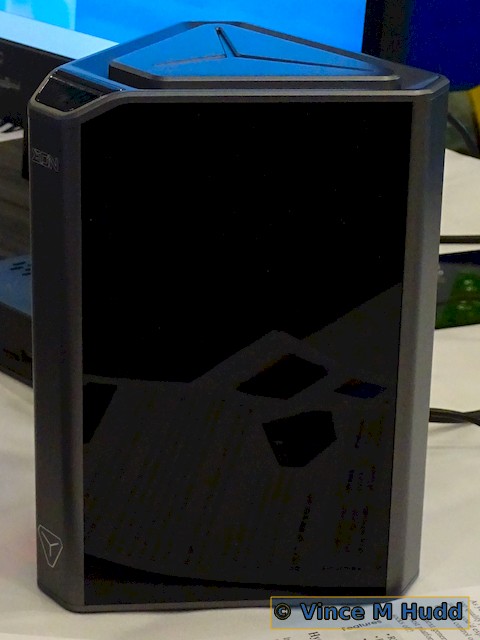
4tissimo! is the latest machine in the 4té range. Still based on the Raspberry Pi 4, the rather cool looking case can house up to four SSDs as well, so if you have a machine that can boot into Linux as well as RISC OS, there could be a dedicated SSD for that operating system, as well as a separate shared one, for example.
Another interesting feature is that, unusually for R-Comp’s machines, which tend to use off the shelf cases, this one is ‘badged’ – note the 4té logo at the top in this image:

In fact that’s a bit of a cheat – R-Comp haven’t gone to the expense of having a custom-badged case for this computer, instead they’re making use of a feature of the case they’re using; a small OLED display, that can be updated from within RISC OS thanks to a module developed by Rick Murray, in this case showing the logo, but it can be put to other uses as well.
Andrew discussed the new machines in his talk in the show theatre, and also touched on the Pinebook Pro laptop and a couple of items of software – PhotoDesk, which R-Comp now handles on behalf of XAT, and CLFiler, which they were selling on behalf of Cloverleaf:
13 AMCOG Games
The next exhibitor that would be reached following this path around the show is also the one likely to catch a visitors eye as they walked in the door, being diagonally opposite, before they turned to the WROCC stand. This was where Tony Bartram of AMCOG Games was showing off his range of games for RISC OS.
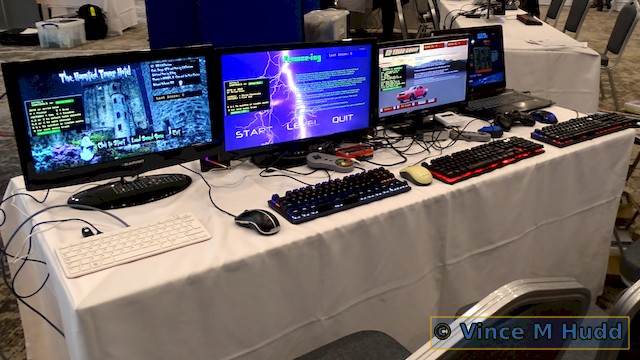
Tony’s newest title, released at the show, was A-maze-ing, a game with hype built in to its name. In this game you play an energy being created by a scientist, who – yes, being a bit mad – has also created a giant organism. Fed energy by autonomous robots, it has grown out of control, so much so that it has even absorbed its creator! Given your own nature, you are the best chance there is of dealing with the problem, so you must explore the laboratory complex, seeking out the necessary chemicals that will ultimately help you defeat the creature.
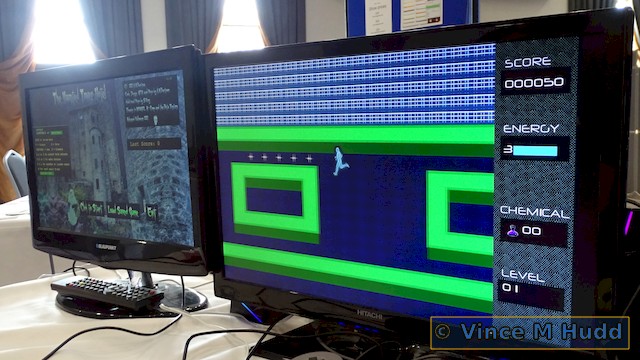
The game adds to an ever growing list of titles available from AMCOG – so many now that Tony had to bring along an extra table, and they were even hanging off the edge of that:
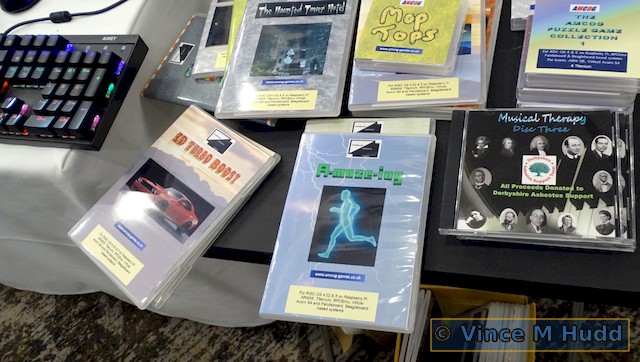
North One Communications Ltd (Organizer)
Nigel Not-Gatherer was on the next stand. He doesn’t really have a double barrelled name that begins with ‘Not’ but I have a terrible habit of referring to him in show reports as Nigel Gatherer, when his name is actually Nigel Willmott, and I have to keep correcting it when Martin Avison points out my error to me.
But not this time, Martin!

Martin, of course, currently develops Organizer, the – no, THE – personal information manager for RISC OS, with Nigel handling the sales through North One Communications.
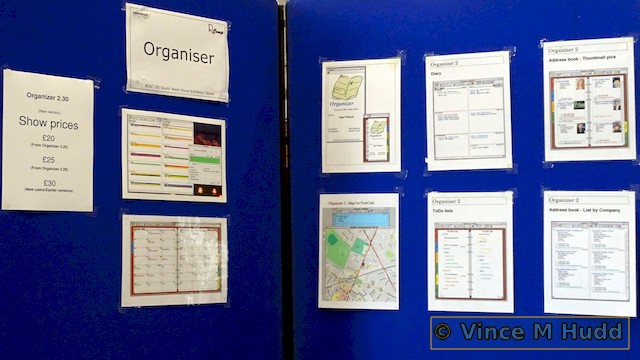
A new version of the software was released on the day of the show, which is the first major update in a few years, with other recent releases having been minor updates to version 2.29. The headline feature in version 2.30 is the addition of an ‘Event Colours’ feature, so that any alarms, anniversaries, or other recurring (or one off) entries in the calendar can be assigned a colour. This enhances the calendar because with just a glance you can see if you have any RISC OS-related events coming up – they will be the ones coloured green. Anything else can be the same colour as the background because, you know, things like appointments with bank managers, people’s birthdays, etc., just aren’t as important. Ahem.
Coming as a chargeable update, the new version is available in download form, but also at shows on a USB stick, pre-installed in a copy of the latest version of emulator RPCEmu, allowing it to be used on any Windows computer into which you can insert it.
Chris Hall
Moving along, and Chris Hall could be found on the next table – and quite easy he was to find, as well; there was no need to use a map or a satellite navigation system, or anything. However, just in case, once you found him, he was able to reveal where he was on a map:

Chris was showing off the latest iteration of his SatNav software and, in this case, not custom hardware, because it was running on the PineBook Pro, using a GPS unit connected to the laptop via USB.
Well, I say he wasn’t showing off his home-brew kit, but in fact he was – because as well as now being able to use it with RISC OS running on the laptop, it’s also still possible to put together your own kit and use it on that – and to facilitate this, Chris was selling a small PCB he’d designed and had made up to house some of the key components in a neater, more compact way. This came with all the instructions so that you could source those components and build your own RISC OS satnav system.
And if you dig deep in your memory to the Southwest Show – or perhaps just to earlier in this report – you’ll remember that RISCOSbits unveiled a new development at that show called RISC OS FAST. This is available both as full-blown computers and in a kit form, allowing people to put together their own FAST machines – which is exactly what Chris has done:

Chris was also showing off his RingBind software, designed to simulate a ring-bound manual but on screen, with a gimmicky page turning effect, and was selling some actual manuals – one for Impression (which comes with a link to download Impression Publisher Plus 5.13 for use with Aemulor on modern machines), and a supplemental one covering other software provided with Impression, such as Equasor and Wordworks – both having been updated.

Soft Rock Software
And so we come to my own stand – Soft Rock Software.

Here I was showing off and (in theory) selling a number of things – the 2020 ‘extended remix’ of Escape from Exeria on CD (full HD graphics, new sound effects, double the number of screens with a new challenge on the extra forty), the Soft Rock Software Collection on CD and USB (a whole bunch of software that can be found on the website, and more that should be there but isn’t), and my remaining stock of RiscPiC cases for the Raspberry Pi.

The RiscPiC cases come in two styles as seen in the photo above – the RiscPiC-mini and the RiscPiC-standard (although the ones available aren’t either black or red – those are prototypes; the ones available to buy are white), and I still have a few of the -mini version available:

As for the RiscPiC-standard, I only ever had one batch of these made, and I’m now down to the very last one (prototypes aside) – and that’s no longer available to buy! However it is available to someone! If you want be that someone, make sure you come to the MUG Xmas Market and buy a raffle ticket. Do that and you might end up walking away with it.
And as well as theoretically selling this stuff, I was also showing off some test levels for a planned update to another old Soft Rock Software game, Drop Rock – as being played by ROUGOL’s Bryan Hogan here:

Progress on the new version is slow (I haven’t touched it since before Wakefield!) but the basic plans are larger levels (benefiting from running at full HD resolution), with new graphics and sound effects, new monsters and puzzles, and so on.
Educraft
The next exhibitor was Educraft, taking both stands 17 and 18, although the billing had Retro Software on 17, then Educraft on 18.
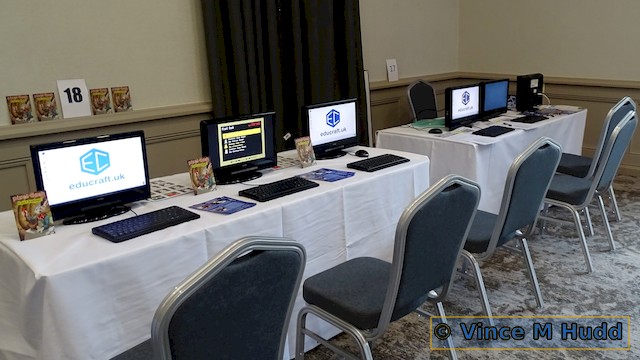
Both are run by Dave Moore, and he decided to use both stands for Educraft, his educational initiative, which aims to get kids interested in all things computing – using them, programming them, and even building them, through workshops and events in schools and at other exhibitions.

There was a Repton-style game to play on the stand at the show – but it wasn’t just to play; it included an editor to allow people to (re)design the graphics used in the game, which can provide younger players in particular with an additional angle to keep them interested, as well as getting them started with a particular skill set.
Retro Hardware/Baildon Electronics
Dave Hitchins came next, with his range of Retro Hardware aimed at older Acorn computers, of both the 8 and 16-bit variety.
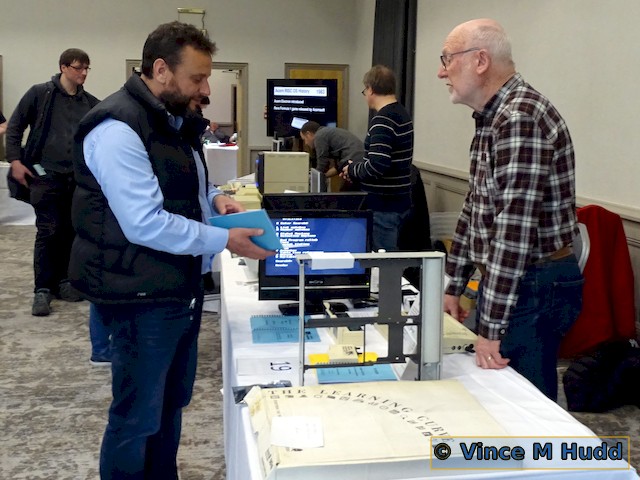
Dave became involved in the Acorn market around the time of the Acorn Electron, and worked with P.R.E.S., where he designed a number of hardware add-ons for the BBC Micro’s little brother, and later with Ian Copestake Ltd, who also produced hardware and software for the 32-bit machines.

Daniel Jameson – Acorn and BBC Micro User Group
The penultimate exhibitor was Daniel Jameson of the Acorn and BBC Micro User Group (ABUG).
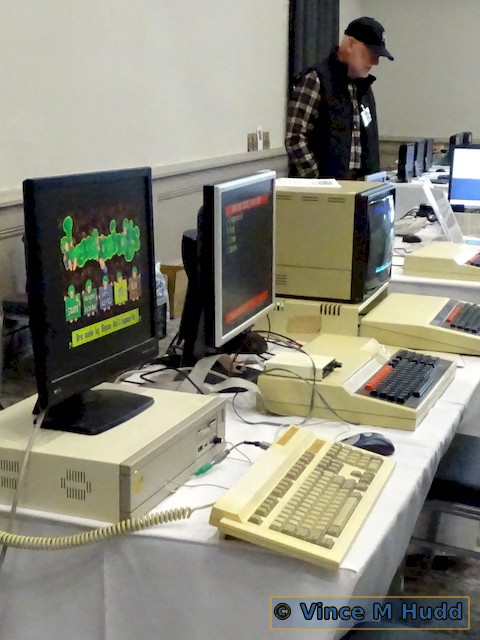
Daniel had brought along a selection of older computers to remind of us of what they used to be like, when the only people likely to have any were those who were interested in them, before they became more of a household item that almost everyone has in one form or another.
i.e. when computing was more fun than fundamental.

I gather there was a wide selection of software available to use on the computers, all apparently being loaded from a server using Econet.
Chris Sawer
The final exhibitor was Chris Sawer, who had brought along a couple of 8-bit computers – a BBC Model B (I think), and a BBC Master.

Not just any old BBC computers, though, there were a number of enhancements to them, such as a Raspberry Pi-based second processor in (I believe) the Master, which allows it to emulate the various other second processors that could be had for the machines but, being internal, without taking up the desk space of one of the old cheese wedge devices that would be placed alongside.
Chris has a number of open source projects for the old 8-bit computers, and is developing software for connectivity between the BBC computers and more up to date machines running Linux – and it seems that I didn’t take my photos at the right time of the day because later, a version of Wordle was running on one of them.

Some additional historical interest
Although Chris was the final exhibitor in this virtual walk around of the show, there were two other exhibits of sorts. The first of these was immediately after Chris’ stand, where there was a large screen showing a slideshow of the history of Acorn and RISC OS, which was running on a Raspberry Pi Zero attached to its rear.
And WROCC’s Peter Richmond had brought along a selection of old Acorn and RISC OS computers, which were on display at the back of the room used for the show theatre. The display included an Archimedes, an Electron, an A9Home, a RiscStation 7500, and a Microdigital Omega.

So that was Wakefield 2023!
There were new and interesting things on display, as we now pretty much expect for one of the main shows in the RISC OS calendar. Both exhibitors and visitors were upbeat and saying positive things – and the organisers say there were more people through the door.
And there was cake.
Wakefield 2023 was therefore a jolly good outing, with lots to see, do, and buy – and hopefully that will be repeated next time around. In fact, if you have your diaries handy, the Wakefield show will next be held on 27th April, 2024 – again at the Bradford Cedar Court.
However, returning to what I said at the start of this report, as you’ll have noticed the last few exhibitors were all from the retro scene. There is an argument that the whole of RISC OS is part of the retro scene – including the newer hardware and software – but while I acknowledge the point of that argument, I do still see a distinction between ‘modern’ RISC OS and the retro aspect within the community. I’d go so far as to say they are two distinct communities with a degree of overlap due to the origins and nature of RISC OS.
And therein lies a key part of the problem – that overlap isn’t huge, which meant that while there were a few times that the left hand aisle was notably crowded, it was mainly people interested in the distinct retro scene, rather than the overall one that encompasses RISC OS. People more interested in RISC OS itself, and the newer hardware and software available for it, seemed to venture less into that area of the show.
With only smaller RISC OS exhibitors on the opposite side of that aisle to the retro guys – Organizer on stand 14, Chris Hall on 15, and Soft Rock Software on 16 – there really wasn’t much to draw the visitors who were there for RISC OS.
Soft Rock Software is, of course, my business, and while my sales at shows have always been low, it’s nice to sell enough to make attending worthwhile – bearing in mind that Wakefield is the most expensive one for me to exhibit at, with the cost of a round trip of approximately 400 miles and two nights in a hotel to cover.
I admit I make doing so difficult myself by wandering around the show, taking photographs and talking to some of the other exhibitors, but I do this for the benefit of RISCOSitory readers and RISC OS users who are unable to make it to the show – I consider doing so therefore something of a necessary evil. Even while wandering, though, I tend to keep a crafty eye on my stand, and try to make a beeline for it if it looks like there are potential customers hovering.
But this layout and the position of my stand made the problem so much worse this year – you can count the number of paying customers I had using the fingers of one hand, on which all but one finger had been chopped off.
Yeah. That means just one sale.
You can see, therefore, why I’m a bit disappointed about that and, as I said, while I accept my wandering the hall is always a factor, I do feel the show layout contributed in a big way to the problem this year. So much so, that I have to consider whether the show will be worth attending in future.
I do intend to exhibit at the 2024 event, but if I come away from it feeling let down by the way it’s laid out, I will have to give serious consideration as to whether I can afford to do so subsequently.
Now look at some more pictures – and I hope to see everyone again at the MUG Xmas Market on 9th December, followed by the Southwest Show on whatever date in February that will take place (come on guys, if you’ve sorted the date, get it out there!)




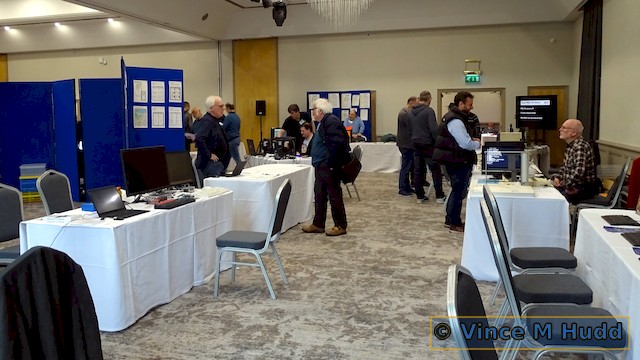

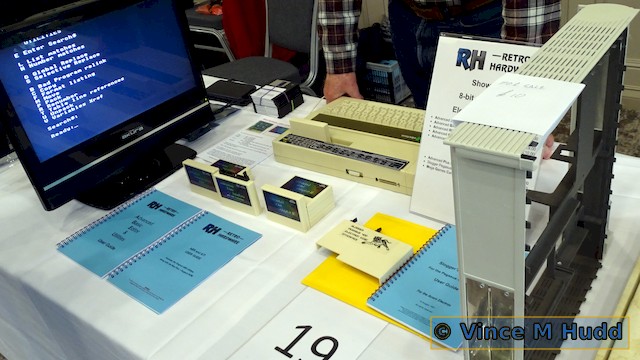




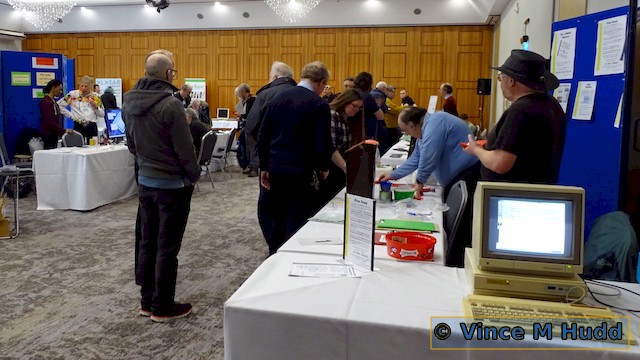


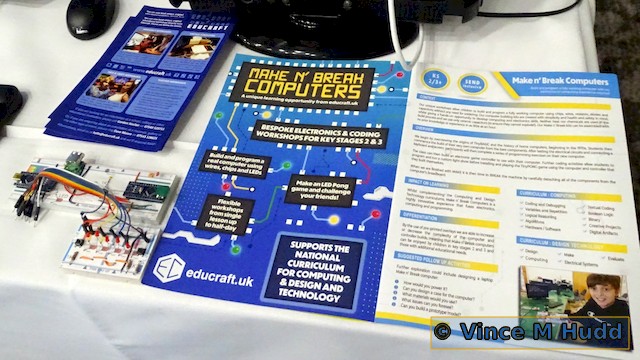
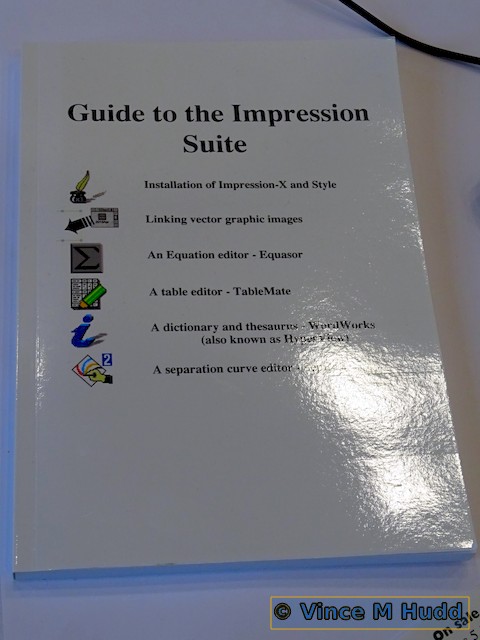



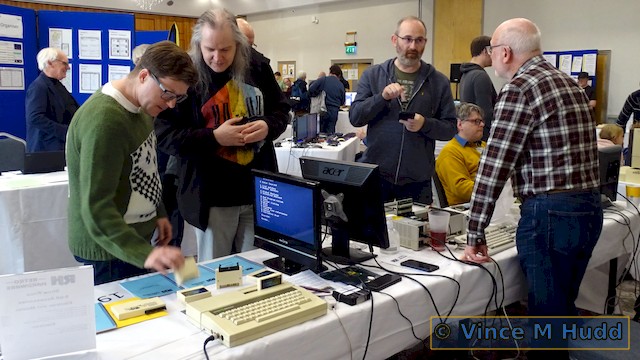

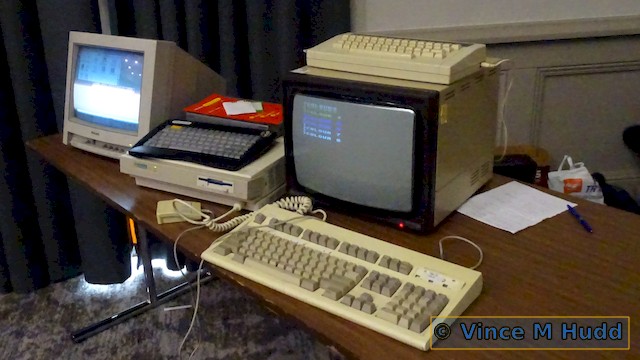


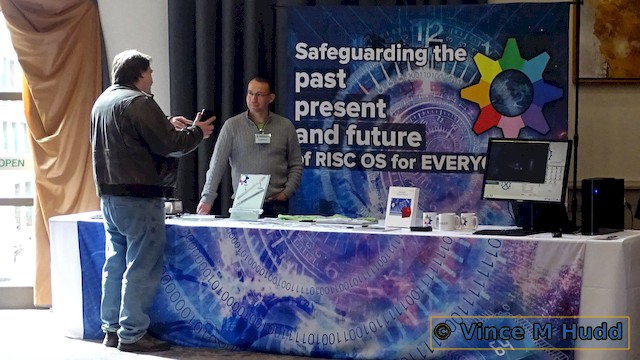





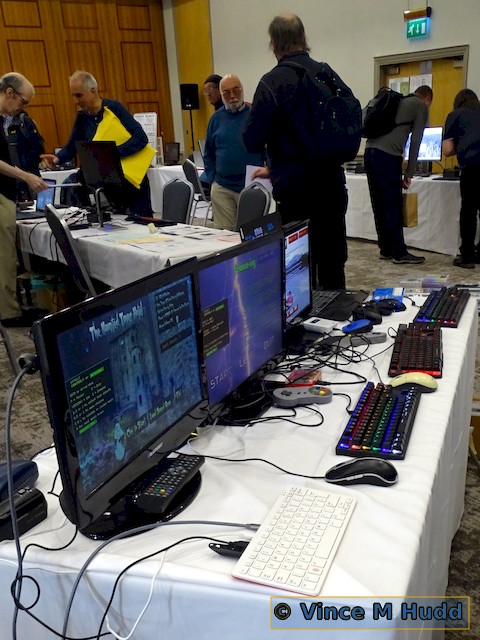



Oh, and I almost forgot – we were playing a game, weren’t we?
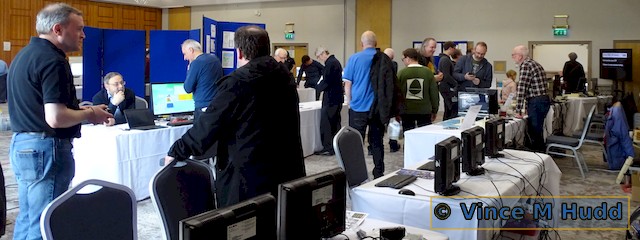
(He may also be in the background in other pictures – but he’s a little more prominent on the left of that one.)




